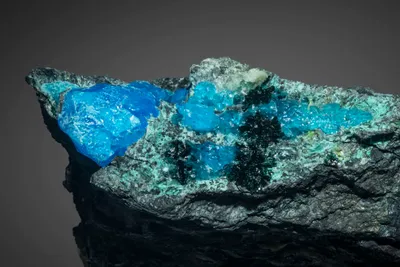Mineral Species
Erikapohlite
Type Locality
Yes
Composition
Cu2+3(Zn,Cu,Mg)4Ca2(AsO4)62H2O
Crystal System
Monoclinic
Status at Tsumeb
Confirmed (type locality)
Abundance
Extremely rare
Distribution
Third oxidation zone
Paragenesis
Supergene
Entry Number
Species; TSNB120
Type Mineralogy
The type specimen is from 44 Level in the third oxidation zone and was purchased by Georg Gebhard in Tsumeb, in 1994. Gebhard (1999) listed the unidentified mineral as "GS5" and described it as a "Ca-Cu-Zn-As mineral" occurring as blue fibres associated with koritnigite. Erikapohlite, IMA 2010-090, was described by Schlüter et al. (2013) and named to honour Dr Erika Pohl-Ströher (1919-2016) who generously placed a large selection of specimens from her private mineral collection on permanent loan for public display as Terra Mineralia, at the Freudenstein Castle in Freiberg, Germany. Type material is conserved in the collection of the Mineralogisches Museum, Universität Hamburg, Germany (catalogue number TS117c).
General Notes
Erikapohlite was discovered on 44 Level, where it occurs as 0.7 mm-wide seams of very thin, deep blue, lamellar microcrystals in granular quartz. It is an oxidation product of tennantite.
Erikapohlite is the calcium-dominant analogue of keyite. Small zones in erikapohlite are Mg- or Cu-dominant, representing new species that have yet to be characterised. The type assemblage includes quartz, lammerite, conichalcite, and another unknown amorphous, brownish, transparent Zn-Fe-Cu-(Mg,Ca) arsenate.
Associated Minerals
conichalcite; lammerite; quartz; tennantite-(Zn); zincolivenite


